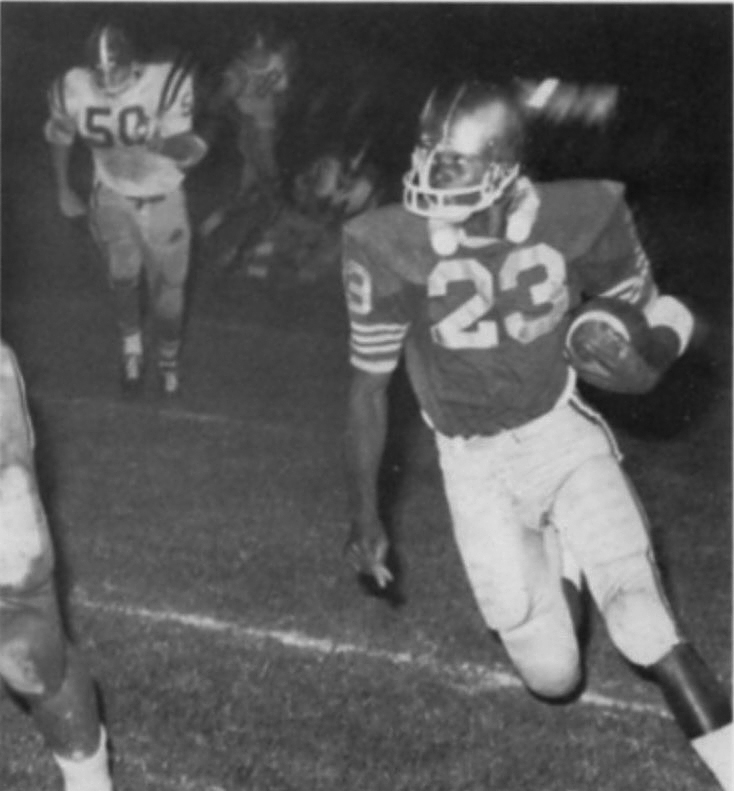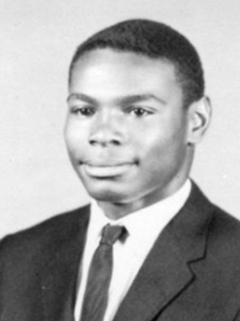By Trey Williams
He wasn’t big, but Gary “Biggie” Carpenter made a huge impact on Science Hill athletics during its initial years of integration.
Carpenter, a rising sophomore when Langston High School closed after segregation in 1965, was the primary ball-carrier on the Science Hill’s football team as a junior and senior in the fall of 1966 and ’67.
With talented quarterback Tommy Sholes keeping defenses honest and a hammer of a lead blocker in fullback Lawrence Jackson, Carpenter, who died last week, was All-Big Seven in ’67.
He also played baseball as a senior during coach Dennis Greenwell’s first season succeeding John Broyles in 1968. He batted cleanup and played left field.
Carpenter was also a senior in football during Bob “Snake” Evans’ first season taking over for another Science Hill legend, Kermit Tipton. The Hilltoppers went 10-1 and their lone loss was a 14-6 setback to Knox Central in a game when Carpenter only carried the ball twice due to an ankle sprain.
Carpenter rushed 15 times for 135 yards and a touchdown in a season-ending 26-13 defeat of Dobyns-Bennett that completed an unblemished run through the Big Seven Conference. His 8-yard touchdown run and Sammy “Dee Dee” Stuart’s PAT kick gave Science Hill the lead for good (13-6) with 5:54 left in the first half.
“Biggie was a great football player,” said Emory Hale, an assistant coach under Tipton who went on to coach Oak Ridge to three state titles before becoming the head coach at Austin Peay. “We had some really good players come in (after integration) – Charles Buford, Dee Dee, Percy and Red Gillespie. I’m telling you, they were some kind of athletes.”
The 5-foot-10 Carpenter, who was listed at 150 pounds as a junior and 165 as a senior, caught a 56-yard TD pass and ran for scores of 37 and seven yards in a 25-13 win at Oak Ridge his senior season. He rushed for 120 yards against the Wildcats.
Carpenter scored all 18 points of the first half. Oak Ridge trailed 25-0 before scoring 13 in the fourth quarter.
He also scored three TDs in a 41-0 win at Unicoi County.
Carpenter’s highlights included scoring on runs of 32 and 29 yards in a 32-6 win against D.W. Daniels (Clemson, S.C.) and a TD run in a 14-0 defeat of Knox Central as a junior. Science Hill finished with an 8-1 record during Carpenter’s junior season, which was Tipton’s swan song.
Jim Baxter was a second team All-Big Seven tackle at Science Hill as a senior in the fall of ’67 and Carpenter’s teammate for three seasons.
“Biggie was our primary running back in ‘66 and ‘67 and he was tough,” Baxter said. “Jimmy Henry and I were discussing Biggie, and he played hurt a lot. He might be in the training room getting treatment all week, but come Friday night he’d be out there and showed no signs of any injury.
“I don’t remember him ever fumbling. He had great speed and power, and probably only 165 pounds. He was a great teammate.”
Carpenter started in left field and batted fourth when Science Hill won a share of the Big Seven Conference with John Whited’s Dobyns-Bennett Indians and Pappy Crowe’s Elizabethton Cyclones in 1968. Center fielder John Bolden led off for the Hilltoppers, shortstop Darrell Cole batted second and future Major League Baseball draft pick Jerry Dempsey, the catcher, batted third in front of Carpenter.
Carpenter was also an exceptional slow-pitch softball player for decades, traveling all over the Southeast for a number of teams.
A year ahead of Carpenter at Science Hill, Jerry Jenkins was his teammate in football and led the Big Seven in hitting as a senior.

“I played tons of softball with Biggie and against him,” said Jenkins, who went on to become the head football coach at David Crockett and head baseball and girls basketball coach at Daniel Boone. “He was one of my personal friends from school. And then after school, the two from that section that followed up with me a lot were Fonzo (Gillespie) and him. Him and Fonzo were big buddies.
“We played for the late Lonnie Lowe. We played for the late Tom Williams. We played for Freddie Hickman. That was three of the main teams when I played with him. Biggie was just an athlete.”
Sammy “Mammy” Simpson was the first African-American to start at quarterback at Science Hill and East Tennessee State. Six years younger than Carpenter, Simpson spent much of his childhood admiring his talent. And he spent much of his adulthood playing softball with Carpenter.
“I was probably 10, 11, 12 years old,” Simpson said, “and I’d go watch him play Babe Ruth and Senior Babe Ruth – him and Melvin Stevens and John Bolden and them. They’d play at the V.A.
“Me and Biggie and Melvin played softball for East Tennessee Mills. I tell ya, that boy had a quick bat, man. To be so small, Biggie could kill that ball. I mean, I’ve seen him hit at least two or three home runs a game when we played in the Smoky Mountain classic down in Maryville and the Pic-O-Dixie in Chattanooga and the Conway Twitty in Nashville and the Louisville Invitational in Kentucky.”
Carpenter hit blasts before technology had made home runs nearly as commonplace in softball for most players in these parts.
“Their fences in Louisville were 320-something, and he’d hit it over it,” Simpson said. “And he probably didn’t weight more than 170 pounds.”
Simpson and Jenkins each noted Carpenter being kind and comically candid.
Simpson laughed recalled a game when East Tennessee Mills exciting run in the Pic-O-Dixie in Chattanooga screeched to a halt against a team comprised with a nucleus of players that also played for national power Howard’s Furniture. Coach Tom Williams relieved the pitcher at some point in the first inning.
“I think they scored 27 runs in the first inning,” Simpson said. “Tom Williams came in for our pitcher – it might’ve been Jackie Baldasano – and Tom said, ‘I’m gonna put out the fire.’ And we got beat something like, 66-11. They were killing Tom worse than they were the first pitcher, and Biggie went up there to the mound and said, ‘Hell, Tom, you’re putting that fire out with gasoline.’”
Charismatic and fun-loving, Carpenter wasn’t opposed to burning the candle at both ends.
“He could play anywhere, infield, outfield – it didn’t matter,” Jenkins said before pausing to chuckle. “He was going to have his good times, though.”
Simpson was always eager to watch Carpenter play on Friday nights in Memorial Stadium.
“Biggie was quicker and faster than you thought he was – with those bowed legs,” Simpson said with a chuckle. “And he could run over you. He could do it all.”
Carpenter’s athletic versatility made an impression.
“He had a quick bat and he was a good ballplayer,” Simpson said. “He played shortstop and second base for East Tennessee Mills. And he wasn’t a bad basketball player. He just didn’t have a nice-looking jump-shot. He had the worst jump-shot you’ve ever seen, but he wasn’t a bad basketball player. We played at Carver, but also used to play a lot of basketball at the old Boys Club.
“He could play golf too. But it killed him when I’d beat him.”
It was killing Hale when Carpenter briefly quit the football team one year. Carpenter was making more money pumping gas than he was playing football. But Hale snuck up to Carpenter at the “filling station” incognito to mend fences.
“Coach Hale went down there between practices with a wig on to get gas and got Biggie to come back,” Jenkins said laughingly. “Biggie really had just a great attitude and a loving spirit. He was very kind and caring. He’ll be missed.
“He was our tailback. He was an athlete. I mean he played to win, played hard. He was just a friend. I’ll never forget him.”




